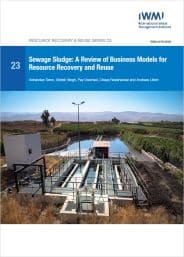Resource Recovery & Reuse – 23
Citation:
Taron, A.; Singh, S.; Drechsel, P.; Ravishankar, C.; Ulrich, A. 2023. Sewage sludge: a review of business models for resource recovery and reuse. Colombo, Sri Lanka: International Water Management Institute (IWMI). 98p. (Resource Recovery and Reuse Series 23). [doi: https://doi.org/10.5337/2023.211]
Abstract
In many low- and middle-income countries, sewage sludge generated from wastewater treatment systems has potential environmental and health hazards. To tackle this challenge, there is a need for innovative options given the increasing concerns and policies restricting sewage sludge dumping in landfills and elsewhere, and a growing awareness about the resource value of sludge within a circular economy. In developed countries, water utilities, municipalities and the private sector are increasingly engaged in utilizing and innovating modern resource recovery technologies to capture biosolids, nutrients or energy from sewage sludge and reducing disposal.
This study reviews existing approaches and business models for resource recovery and moves the discussion beyond technical feasibility. Case studies were analyzed in support of four main sets of business models depending on the targeted resource: (i) organic fertilizers, (ii) crop nutrients, (iii) energy, and (iv) organic fertilizers and nutrients along with energy. The extraction of organic fertilizers through dewatering, thickening, stabilization or long-term storage drives the first set of models followed by technological advances in phosphorus recovery. The business models on energy similarly start from conventional energy recovery processes (anaerobic digestion) and move toward incineration. The discussion covers recent advances in gasification and pyrolysis. Transforming sewage sludge into biochar, for example, can support soil fertility and carbon sequestration. The final set covers integrative approaches supporting soil fertility and energy needs.
The critical step for emerging economies is to develop a wastewater management strategy and link it to a circular economy framework without having a negative impact on environmental and human health. While technologies and business models generally have a favorable policy environment, there is a lack of a regulatory framework that allows the marketing, use and export of recovered (waste-derived) resources for certain applications. For example, there needs to be an increase in industry acceptance of phosphorus recovered from sewage sludge to penetrate agricultural markets despite the currently still cheaper phosphate rock, which is a finite resource.
ISSN 2478-0510 (Print)
ISSN 2478-0529 (Online)
ISBN 978-92-9090-951-4


 Download PDF 3.45 MB
Download PDF 3.45 MB